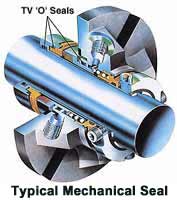Installation and Service Life
 In general, the same regulations apply to installation of encapsulated o-rings as for conventional elastomer o-rings. Due to FEP encapsulation, these sealing rings can neither be squeezed into place as easily as the purely elastic o-rings, nor do they contract as easily after stretching. To avoid unnecessary distortion of the encapsulation when the ring is installed, a split groove is recommended for radial-static and dynamic installation.
In general, the same regulations apply to installation of encapsulated o-rings as for conventional elastomer o-rings. Due to FEP encapsulation, these sealing rings can neither be squeezed into place as easily as the purely elastic o-rings, nor do they contract as easily after stretching. To avoid unnecessary distortion of the encapsulation when the ring is installed, a split groove is recommended for radial-static and dynamic installation.
When used for external seal application (e.g. pistons), the encapsulated o-rings must be stretched out and then put back in shape. For installation recommendations, please contact us.
 For internal seal application (e.g. rods), encapsulated o-rings with increasing diameter can be installed. For installation of o-rings with smaller diameters, the possibility of using closed grooves should be investigated in each particular case.
For internal seal application (e.g. rods), encapsulated o-rings with increasing diameter can be installed. For installation of o-rings with smaller diameters, the possibility of using closed grooves should be investigated in each particular case.
The sealing ring must never be forced into the groove by buckling it, since this can spoil the sealing function. In such cases, a split groove must be used.
Encapsulated o-rings are installed in rectangular grooves. For operating pressures higher than approximately 50 bar, additional backup rings can be an advantage. This prevents the FEP encapsulation from being buckled or damaged by sharp groove edges or narrow corner angles.
Function and Service Life (Surface Roughness)
The function and service life of a seal depends on the quality and character of the surface.
 RadialŚDynamic and Static
RadialŚDynamic and Static
Bore/Rod
Ra = 0.05-0.6 Ám [Rmax = .02-2.5 Ám]
Groove Surface, Static
Ra < or = 2.5 Ám [Rmax < or = 10 Ám]
Groove Surface, Dynamic with pulsating pressures
Ra < or = 1.5 Ám [Rmax < or = 6 Ám]
Axial-Static
Seal and Groove Surface
Ra < or = 2.5 Ám [Rmax < or = 10 Ám]
with Pulsating Pressures
Ra < or = 1.5 Ám [Rmax < or = 6 Ám]
If you need more information on installing your o-rings please e-mail Info@Has-Mor.com or call (570) 383-0185.


 Product Information
Product Information